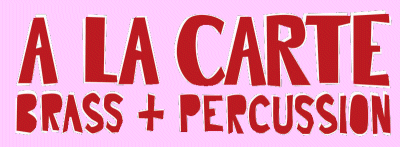
![]()
Volume 4, Issue 1

![]()
Volume 4, Issue 1

|
The restless minds at Mapleshade have come up with a tangy melange
that taps several Crescent City styles and then some. A La Carte
Brass & Percussion emerged from the marriage of a New Orleans-style
brass band with the percussion from a salsa big band. New-born
"Go-Go and Gumbo, Satchmo 'N' Soul" follows in the the
footsteps of Wildchild! #02452, the ensemble's first release.
Unified by Crescent City culture and a brass-rich ensemble including two saxes and a tuba (often doubled by baritone sax) for the bass, this robust collection is surprisingly varied. The A La Carte ensemble is no rag-tag street-band; these guys have charts and can play tight. The thing is, brass bands have staged a comeback and are not willing to settle for the sound of a polyphonic free-for-all; from the Dirty Dozen to the Nightcrawlers, younger members have injected bebop, funk, and now hip-hop into the traditional mix of spirituals and twosteps. Arrangements set up contrasts and structure the interplay between sections of the band. On this disc, tracks such as Freddie Hubbard's gentle Sunflower even take on a modernist coloration that recalls Gil Evans or Oliver Nelson. The distinctive Mapleshade sound, achieved with minimalist use of microphones, depicts a sound stage so deep and realistic as to convince the listener he has just dropped in on a band rehearsal in a large, almost empty social club. The for-real venue is a letter carrier's union hall in Washington, D.C., chosen for its clean reverberation." "Hey Pocky Way," a funky Mardi Gras/second-line anthem caught my eye. Known from versions by the Meters (recorded in 1974), Wild Tchoupatoulas (backed by the Meters), and The Neville Brothers (Live at Tipitina's), its high-strutting rhythm and mambo svncopations seemed guaranteed to galvanize any (Funky) Meters' live audience. "Standing On The Verge" (by George Clinton of P-Funk) has a real rhythmic snap and a meatier arrangement which the band plays with verve. The rhythmic style here is more '90s, and main singer Chuck Brown, "the king of D.C. go-go," is in his element. The cover boasts a label, "raw music ... no additives." The inside notes confirm that the sessions were 'mastered live to two-track analog tape ... digitized on the Mapleshade custom A/D converter ... (with) minimum miking and minimumlength cabling ... no mixing board, filtering, compression ... multitracking or overdubbing." The recording renders the slambang tuttis of trumpets and drums with open-throated ease and realism. Musicians are vividly depicted in relation to each other, and all the music has presence and immediacy in the smaller ensembles. As with most good R&B albums, there is stuff I've got to hear again soon, and that is certainly the case here. My three favorite tracks are "Saint James Infirmary Blues," "San Pedro," and "Lucky Old Sun," each quite different from the others. "Saint James Infirmary Blues" starts with a gut-wrenching "uhg! ... ahh!" and settles into a mysteriously minor-keyed mambo. (This gets my wildchildren gleefully doing a curious faux-Egyptian sort of dance.) Peter Ostle's tuba here is just right, evoking the '20s and earlier versions of this terrifying tale. Best of all is Chuck Brown. His husky voice has a hint of vibrato that'suggests he could have been a crooner, but this is no ordinary love song, and he gets the story across as if he's lived it himself. The trumpets have a Cuban richness and fire, and the trombone chorus is a high point. "San Pedro," features only percussion and voice. Nelson Rodriguez and Rob White are credited as singers, but it sounds like essentially one singer, probably Rodriguez. His frayed, thoroughly untutored voice is the sound of a Caribbean Everyman singing a stream of consciousness in some equatorial town square. These vocalizations are like pure, improvised folk music. The leisurely pace and world-weary inflections, interwoven with calmly conversational drumming, are at once highly personal and universal. The beautifully recorded drums (here sounding closer to the mikes than the tracks with larger ensembles) suggest some complex force of nature, like light glancing off a forest stream. This unique showcase for voice and drums allows the listener a peek into a timeless world where musicians with simple means listen and interact. You may wonder why the ensemble, which until now has avoided any trace of electronics, suddenly on track 9 (J.J. Johnson's 'Me Too'), has introduces a synthesizer. Well, it turns out those shimmering digital overtones are emanating from that ancient aboriginal instrument, the didgeridoo. This particular didgeridoo is either especially primitive or quite high-tech, depending on how you regard the fashioning of ancient instruments out of PVC sewer pipe. It sounds great! John Jensen's trombone work is superb, his occasional multiphonics bringing his horn into the blurry soundworld of the didgeridoo. "Lucky Old Sun" is a stately spiritual, resolute and hopeful. Trumpeter J. Howard nowhere strives to be modern, but holds our attention though flexible phrasing and steady purpose; his playing goes somewhere, gradually becoming more bluesy and urgent until this final piece fades away, leaving only the retreating sounds of the percussion's slow-drag march.
This disc has a warmth of spirit and a lots of rhythmic appeal, and
I admire what Mapleshade is doing. The recording of every piece
naturally evokes a soundstage of depth and dynamic range, yet one
or two tracks lead me to question the premise of recording a
large outdoor ensemble in such a resonant interior. I look forward
to sharing faves with friends (eh ... er... make that singular) but
its so hard for such a crotchety critic to find a pal when guys
only want to sit back and enjoy the good-time music. |